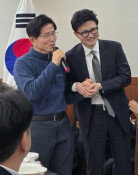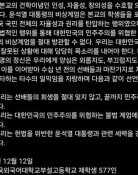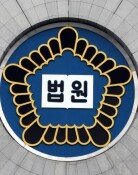[Editorial] Shame on our generation
[Editorial] Shame on our generation
Posted February. 12, 2008 03:02,
It is embarrassing to tell what happened last night to our children. When the dawn broke, people were at a loss for words as they watched the charred remains of the National Treasure No. 1, Sungnyemun (Namdaemun). The burden of guilt weighs heavily on our shoulders as we let one of Koreas most precious cultural properties turn into a heap of ashes. The second floor of the two-story wooden pavilion, which once boasted its magnificence at the heart of Seoul, collapsed without trace and the first floor is in a critical condition as it may also collapse at any time in the aftermath of the fire. The smoky smell still remaining around Sungnyemun makes us sink into despair once again. Our children will never be able to see the splendor of Sungnyemun as it was, because of our carelessness.
Although it has undergone restoration a number of times, Sungnyemun has always been the main gate of Seoul since it was completed in 1398 during the Joseon Dynasty. It survived a series of tribulations, from the Japanese Invasion of 1592, the Manchu Invasion of 1636 and the 1950-53 Korean War. This can be attributed to our ancestors sacrifice to protect it.
Sungnyemun is the biggest and the oldest castle gate in Korea which has preserved the grandeur of early Joseon Dynasty structures. With a single blunder, we have committed a serious crime of destroying a cultural asset that we can proudly show to the world along with Hunmin jeongeum (Korean writing system), Seokgulam (grotto shrine) and Palman Daejanggyeong (Tripitaka Koreana).
Above all, what is absurd about the incident is that the national treasure was burnt to ashes while firefighters spent five hours without knowing how to react properly, despite the fact that a report was made immediately after the structure caught fire and that fire authorities also shortly arrived at the site. There is no excuse for the Cultural Heritage Administration (CHA) and the National Emergency Management Agency (NEMA) since the fire broke out at the center of Seoul, where numerous fire fighters can reach within a matter of minutes.
Yoo Hong-june, director of the CHA, was traveling overseas at that time. Yoo plays the role of commander-in-chief when it comes to protecting cultural assets, but he is rather notorious for damaging cultural properties. He was even criticized last May for cooking food at the cooking-prohibited area of the Tomb of King Sejong in Yeoju, Gyeonggi Province. The place where he instructed cooking was in front of a wooden structure, similar to Sungnyemun. It would be horrible to imagine what would have happened if the property caught fire during the cooking. How can we prevent such a tragic accident from happening when the person in charge of prevention lacks discipline?
Both CHA and NEMA are blaming each other for the improper response to the fire. NEMA argues that CHA requested them to be careful not to destroy cultural assets when putting out the fire, while CHA argues that it told NEMA that the priority was extinguishing the fire. Eight fire extinguishers were the only anti-fire equipment for Sungnyemun. Only three workers guarded the cultural asset during the day and it was guarded by an unmanned security system of a private security firm at night. In other words, it was highly vulnerable to arson. Not only the arsonist but also the government officials responsible for making wrong decisions in the process of extinguishing the fire must be held accountable.
A number of wooden cultural assets have been damaged by fire one after another recently, showing how negligent we are in protecting cultural properties. A bronze bell, designated as National Treasure No. 479, melted when the wooden buildings of Naksan Temple were consumed by fire in 2005. Munjeongjeon of Changdeok Palace and Seojangdae, or the West Command Post of Hwaseong Fortress, were also set ablaze by arsonists in 2006. It seems just a matter of time when another cultural asset will be lost in fire. The government should make an immediate change to the fundamentals of the existing fire prevention system on cultural assets.
Although the size of our economy has made into the top 10 of the world, public awareness on the importance of cultural properties is not as high. The participatory government destroyed countless cultural assets during construction projects over the past five years, on the excuse of balanced regional development. To make it worse, the government is attempting to pass a bill that makes the excavation of cultural assets mandatory only for development projects involving an area of land greater than 100,000 square meters. Under the current law, the excavation of cultural assets is compulsory for constructions involving an area of land greater than 30,000 square meters. It will make most of the constructions to be conducted without a surface survey for possible cultural properties buried under the ground. The government should be more proactive in protecting cultural properties and the mindset of the people should also become more mature in order to prevent those radical measures from being introduced.
Cultural experts have expressed their anxiety over President-elect Lee Myung-baks cultural policies. They point out that the president-elect did not mention a single word about culture in a press conference given after his election and that the presidential transition team does not have a single cultural expert. It is important to note that, as we have learned from yesterdays fire, we cannot restore the value of a cultural asset with money. The incoming administration should use this tragedy as an opportunity to pay more attention to culture and to draw up policies that seek a balance between culture and economy.
Korea proudly claims to have five thousand years of history. Carefully preserving our cultural properties and passing them to the next generation are the solemn duty of Koreans, people who have long loved culture. The best way to atone to the next generation for destroying Sungnyemun will be restoring its historical details as much as possible. All Korean people should make sincere efforts to help restoring their National Treasure No. 1.





![넘치는 전재수 과거 사진들…유죄의 증거일까, 무죄의 증거일까[청계천 옆 사진관]](https://dimg.donga.com/c/138/175/90/1/wps/NEWS/IMAGE/2025/12/20/132997378.1.jpg)

